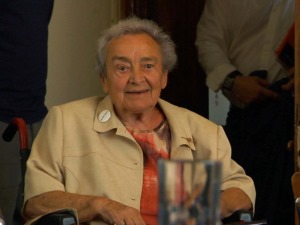A Tribute to Dr. Margaret Rule, CBE, FSA
By John Bingeman, Jane Bingeman and Sean Kingsley
 |
Dr. Margaret Rule meeting with the Maritime Heritage Foundation and Odyssey Marine Exploration. |
Margaret Rule’s lasting and greatest legacy is placing nautical archaeology on a professional footing in the UK. Through the successful raising and recording of the Mary Rose, Britain was gifted arguably the finest marine archaeological crown jewel in the world. The standards that she insisted upon in the hostile, near-zero visibility of the Solent were to be comparable to those achieved on land.
Margaret’s first major landmark was in terrestrial archaeology, discovering and excavating in the 1960s the only known Roman palace in the UK at Fishbourne, West Sussex, and then going on to become the museum’s first Curator. She was responsible for transforming Fishbourne into a major archaeological tourist site and in 1977 published Fishbourne Roman Palace - A Souvenir Guide.
Many archaeologists would have rested content with such an achievement. Not Margaret. She became a founder member of the original ‘Mary Rose (1967) Committee’ with Alexander McKee, which ultimately located the wreck of the famed Mary Rose in 1971. Over time Margaret became the driving force responsible for the project, finally raising Henry VIII’s noble warship in 1982 – one of the world’s greatest archaeological public spectacle watched by a global audience of 60 million people. Very soon afterwards she published The Mary Rose: the Excavation and Raising of Henry VIII's Flagship with a foreword by HRH The Prince of Wales. Never losing heart, despite mammoth difficulties and lack of funding, she even paid bills out of her own pocket (as did many other team members). What a wonderful legacy she leaves behind in the spectacular modern museum standing today in Portsmouth Dockyard. The Mary Rose cemented Margaret’s reputation as the mother of British marine archaeology.
Margaret stood at the forefront in the UK of introducing legislation to protect Britain’s underwater heritage, leading to the passing of the Protection of Wrecks Act in 1973. In 1974 she was invited to become a member of the Advisory Committee formed to review all applications to the Department of Trade for designating a ‘protected wreck site’ and to approve archaeological licences. She was to remain a member of the Committee for nearly twenty years. Before the introduction of the national Advisory Diving Unit in 1986, she personally inspected site applications on behalf of the committee.
Margaret went out of her way to help amateur divers take responsibility for their discoveries. At the Church Rock site at Teignmouth in Devon she advised a 16 year-old Simon Burton, whose find of a Zuane Alberghetti bronze minion cannon led to further discoveries on an important 16th-century wreck. Off St Peter Port, Guernsey, Margaret directed the lifting of an extremely rare 3rd-century AD Gallo-Roman hull, publishing the results of the so-called ‘Asterix’ wreck with Jason Monaghan in A Gallo-Roman Trading Vessel from Guernsey (1993). Her scope of influence extended from shallow-water fieldwork off Cape Verde to the deep-sea scientific revolution: in North America Margaret and Dr Robert Ballard, who found the Titanic, conducted a live TV ‘question and answer’ programme to school children while operating an unmanned Remotely-Operated Vehicle investigating a sunken wreck deep beneath the Great Lakes. With her ever-enquiring mind, Margaret bridged the generations. She held a strong conviction that anyone able to bring the past alive for the benefit of our own and future generations should be helped rather than scorned.
Following John Bingeman’s experiences working as a Mary Rose diver, Dr Rule recommended he take over responsibility of the Needles historic wreck after personally vetting him on-site in almost gale conditions. Following Bingeman’s involvement with another large wreck in the Eastern Solent, later identified as the Royal Navy’s 74-gun first Invincible warship (1758), Margaret agreed to serve as the project’s Archaeological Director and supported John for the next thirty years.
Since 2012 Dr Rule worked closely with the Maritime Heritage Foundation, as Chairman of its Scientific Advisory Committee, to save the First Rate English warship Victory, sunk 80 kilometres off southwest England in 1744. Some campaigners favour leaving the remains untouched at the bottom of the sea. However, at 75 metres down what is one of Britain’s greatest wrecks has succumbed to looting, erosion and damage from fishing trawlers. To Margaret the world of marine archaeology was composed of those who do and those who don’t: she maintained a no-nonsense practical approach to the sunken past and was convinced that inaccessible remains of the premier battleship of the period must be saved and shared with the nation.
Lord Lingfield, Chairman of the Maritime Heritage Foundation, recalled that “Margaret championed the fight for Victory with passion and good sense. She insisted the wreck be selectively excavated to the highest scientific standards – not salvaged – and the fruits of the work exhibited for all to enjoy. To Margaret marine archaeology was a public resource, not an elitist realm solely for heritage managers and academics. We will miss her wisdom and great friendship, but move on to fulfill her legacy.”
Margaret’s husband Arthur, who passed away in 2014, always supported and encouraged Margaret’s journeys into the deep. Both Margaret and Arthur were so proud of their son Nick and his two children, Thomas and Leanne, and enjoyed helping and encouraging them with all their activities.
Margaret Rule, born 27 September 1928, died 9 April 2015
